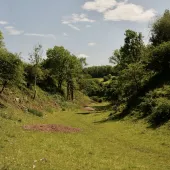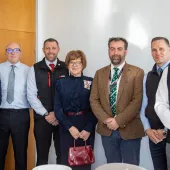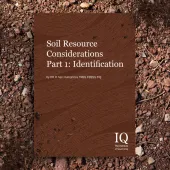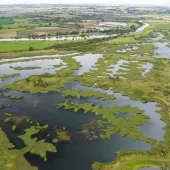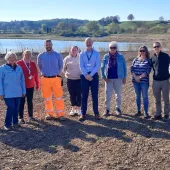Evidence-Based Quarry Restoration
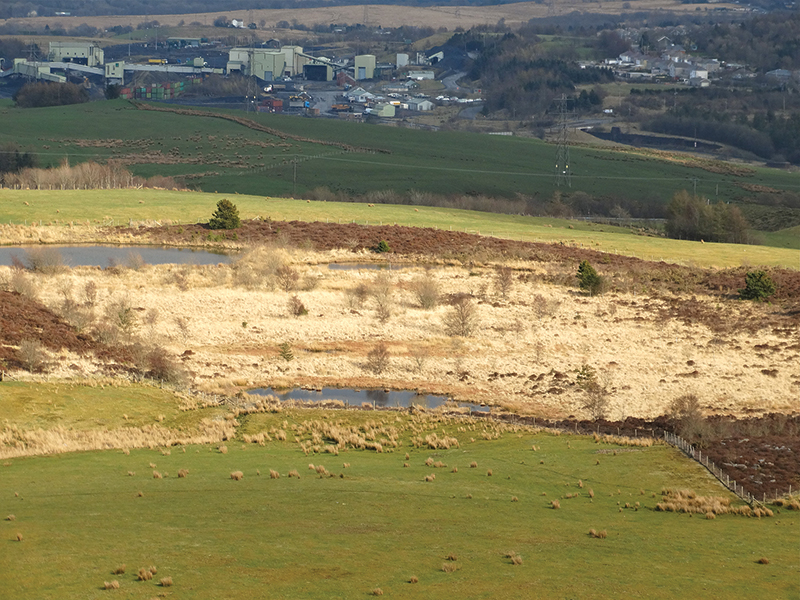
First published in the May 2014 issue of Quarry Management
Responding to the challenges
By Professor Neil Humphries and Rob Thompson
Over decades the minerals industry has made a very significant contribution to the protection and enhancement of biodiversity assets in the UK, and in the last two decades has become a leading champion in this respect, as manifest in the Nature After Minerals and RESTORE initiatives. The early contributions of the mineral industry for biodiversity were very much a laissez-faire approach through natural colonization of abandoned workings, whereas now contributions are largely through deliberate planning and design resulting in significant achievements.
Despite this, and having been encouraged to provide mitigation, enhancement or compensation measures for biodiversity resources by the mineral planning authorities or the conservation statutory agencies, how often have there then been challenges to the proposals put forward, such as: ‘no net loss in biodiversity’; ‘like-for-like’; ‘a ten-fold increase is required’; ‘where is the evidence for successful achievement?’; ‘what is the degree of certainty (guarantee) of success?’; and ‘we don’t think it is achievable?’ This article considers what is behind this recent and growing trend for almost a guarantee of success, and suggests how the industry might effectively respond.
Background to demands for evidence
Has there been a change in government and agency expectations or is it just a matter of progression through experience? In fact, there has been a tectonic change in position, but something that has taken more than a decade to manifest. This can be traced back to the Blair Government coming to power in the late 1990s(1). It adopted an evidence-based approach to legislative and policy-making. The approach was inspired by that used in the medical profession(2) and replaced the largely traditional ideological-precedent-based approach of governments.
The underpinning principle is that the evidence approach is a scientific-based process which is systematic, factual and reasoned. The approach is now fully embedded in the thinking and processes of central and local government, and their agencies, and applied to the protection and enhancement of natural resources such as mineral extraction and biodiversity(3). Hence, there is an inherent expectation that proposals will be backed by evidence in the form of monitoring data and there is a gathering frequency of this being requested.
Expectations of the minerals industry
Simply, the industry is expected to collect the evidence to justify the certainty of delivery of its restoration proposals whether or not it or others are the promoters of the biodiversity initiatives it might contain. So what might the evidence be?
What form of evidence?
There is considerable literature and opinion, including biodiversity and nature conservation, on what form evidence should take. However, much of this is about the process(4) and not the outcomes, which is the strength of the evidence-based approach(1).
There are four generic forms of permissible evidence and Davies(1) in his overview ranks these in terms of value, with case (field) studies as being of the highest, followed in descending value by pilot (field) studies, critical reviews and research, with the least value being expert opinion. Davies is doubtful of the value of expert opinion owing to the inherent risk of introducing their own bias and having out-of-date or incomplete knowledge. He considers research to be a useful tool suited to understanding prescribed aspects of the issues involved whether it was process or technique. Critical reviews do have value but are constrained by similar limitations to expert opinion. In contrast to case and pilot field studies, none of the aforementioned evidence types have tangible outcomes that can be measured and assessed, and, importantly, serve as a track record in delivery of the target functioning ecosystems at an operational scale.
There are differences between pilot and case studies. Whilst pilot studies are at a fully operational scale, they are applicable where there is an absence or incompleteness of knowledge and the outcome is primarily to fill the gap in knowledge. Typically, they would be employed for innovative techniques or unusual habitats at say 0.1 to 1.0ha or greater scales, depending on landscape and habitat contexts, whereas case studies are of fully fledged schemes deploying operation methods at site or ‘phase’ based scales. Both pilot and case studies would be monitored and assessed using standard monitoring and assessment methodologies(5).
What constitutes success?
This has been a much-debated topic over the past 40 or more years and one that is seemingly still rumbling on. Clearly, success is equitable with the full attributes characteristic of the target habitat (eg species composition, community structure) and with being sustainable (ie capable of regeneration in life-cycle terms). The establishment of a complement of appropriate species is not success in itself. What is needed is the recorded evidence of their full development and maturation, and replacement by cohorts of seedlings etc, as well as functioning below-ground soil systems. This accords with the ecosystem services and function approach now adopted for natural resource planning(6).
These ecosystem development processes are time-dependent to establish, and they can vary considerably in duration between habitats. For example, for some grassland ecosystems this might be in the order of 10–15 years, with dwarf shrub (heath) up to 30–50 years, birch woodland possibly up to 150–200 years, and some oak woodlands about 250–300 years(7). Whilst certain intervention practices can be adopted for heath and woodland to reduce these long development and maturation times, the implications are that either long-established examples are required as evidence or examples which have the traits that give confidence that the eventual outcome is likely to be achieved. In adopting the latter approach, evidence to justify the predictions will need to be collected and likelihood (certainty) of the targeted outcome provided.
Implications for the minerals industry
Clearly, for its future, the industry needs to be fully aware of the implications of the evidence-based approach adopted by planners and regulators. In doing so it should be, for its own benefit, collecting appropriate evidence as to its success in the restoration of defined habitats for biodiversity mitigation and enhancement-contributing schemes. This may include looking at past schemes of an appropriate age for the habitat types where such time sequences are not available or achievable from current operations. Given the reality that lead-in times involve decades, the industry needs to be proactive in identifying or setting up pilot and case study schemes to provide evidence for future prospects. Whilst this is not an inconsiderable task, it is one that could be made tolerable by sharing the burden through co-operation and evidence sharing in a strategic way.
Strategic collaboration
Mineral companies generally record their restoration achievements and often use the case study approach for selected sites. This information may be reported through trade and institutional, company or third party media, and sometimes made public by the mineral planning authorities. However, the underlying technical information is difficult to obtain and variable in its quality and relevance. There is no cross-industry standard for its collection, making it difficult to comprehend and use as effective evidence. This is exacerbated by mineral planning applications traditionally being considered as individual entities and on their own merit. Rarely are they considered in the light of the applying organization or the contributions of the industry as a whole.
To this effect, there is a case for creating a ‘national’ repository as achieved by the Cochrane Collaboration (www.cochrane.org) for medical policies and practices. This might be an institution that has the capability to collate and provide objective science-based assessments or it could be an industry-based initiative(8).
What is clear is that there is an opportunity and strong case for all sectors of the mineral industry to come together and share their future technical challenges and information. The adoption of a strategic approach to evidence gathering will ultimately benefit all and ensure that the industry is able to respond to future demands for science-based evidence for its proposals in a timely and full manner, and to the benefit of future biodiversity assets in the UK. Then we shall be certain that ‘like-for-like’ is being provided, there is resulting ‘no net loss’, and without undue risk.
ACKNOWLEDGMENTS
The authors are grateful to Celtic Energy Ltd for permission to publish this article, but the views expressed are solely those of the authors. The support of Celtic Energy’s mine managers in allowing the case and pilot studies to be established within their operations is acknowledged.
REFERENCES
- DAVIES, P.: ‘Is Evidence-Based Government Possible?’, The Jerry Lee lecture, 4th Annual Campbell Collaboration Colloquium, 2004, Washington D.C.
- GRAY J.A.M.: ‘Evidence-based Healthcare: How to make Health Policy and Management Decisions’, Churchill Livingstone, 1999, New York.
- Parliamentary Office of Science & Technology, POST Note PN379: Evidence-based Conservation, 2011, Houses of Parliament, London.
- SUTHERLAND, W.J., PULLIN, A.S., DOLMAN P.M., and T.M. KNIGHT: ‘The need for evidence-based conservation’, Trends in Ecology & Evolution, 2004, no.19, pp305-308.
- HUMPHRIES, R.N.: ‘Why reinvent the wheel when there are established methodologies to aid the design and assessment of restored natural ecosystem on mined land?’ (in press), Life-of-Mine 2014 Conference, 2014, Brisbane.
- UK National Ecosystem Assessment, ‘UK National Ecosystem Assessment: synthesis of key findings’, 2011, UNEP-WCMC, Cambridge.
- HUMPHRIES, R.N.: ‘Understanding and delivery of the components of structure, diversity and function in the restoration of ecosystems on mined land: working towards a practical methodology’, Journal American Society of Mining and Reclamation, 2013a, Vol. 2, (2), pp1-31.
- HUMPHRIES, R.N.: ‘The requirement and implications of evidence-based restoration schemes in the United Kingdom’, pp 355-361, in (eds) Tibbett, M., Fourie, A.B. and C. Digby, Proceedings of the Eighth International Conference on Mine Closure, 2013b, Australian Centre for Geomechanics, Nedlands.
Notes on the authors
Neil Humphries is a Fellow of the Institute of Quarrying, recipient of the Institute of Quarrying’s Ruston Bucyrus Award for best paper in 1999 on Biodiversity & the Mineral Extraction Industry, and recipient of 2013 American Society for Mine Reclamation’s William T Plass Award for his national and international contribution to reclamation of mineral workings. He currently works part-time as natural resources manager for Celtic Energy Ltd, acts as an independent consultant and is a visiting Professor at Cranfield University’s National Soil Resources Institute. Rob Thompson is a Member of the Institute of Quarrying, has a 1st Class Honours degree in Surveying for Resource Development, and 20 years’ experience in the mining and quarrying industry. He is currently a director of Celtic Energy Ltd with responsibility for mining operations, planning and development, and health and safety.



